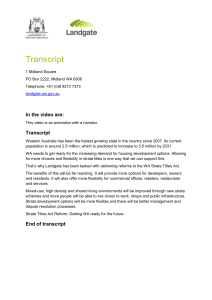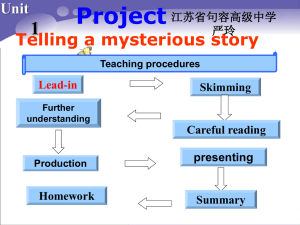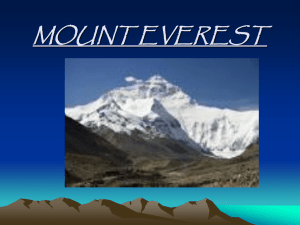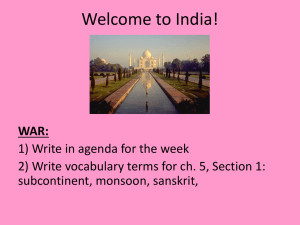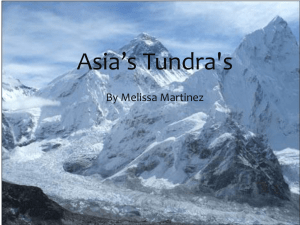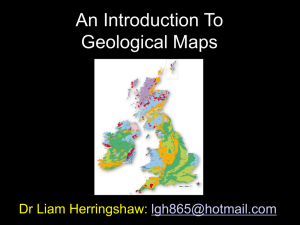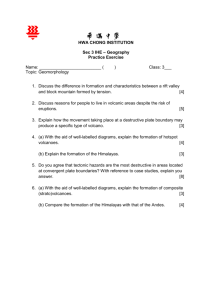File - A Study on Plate Tectonics
advertisement
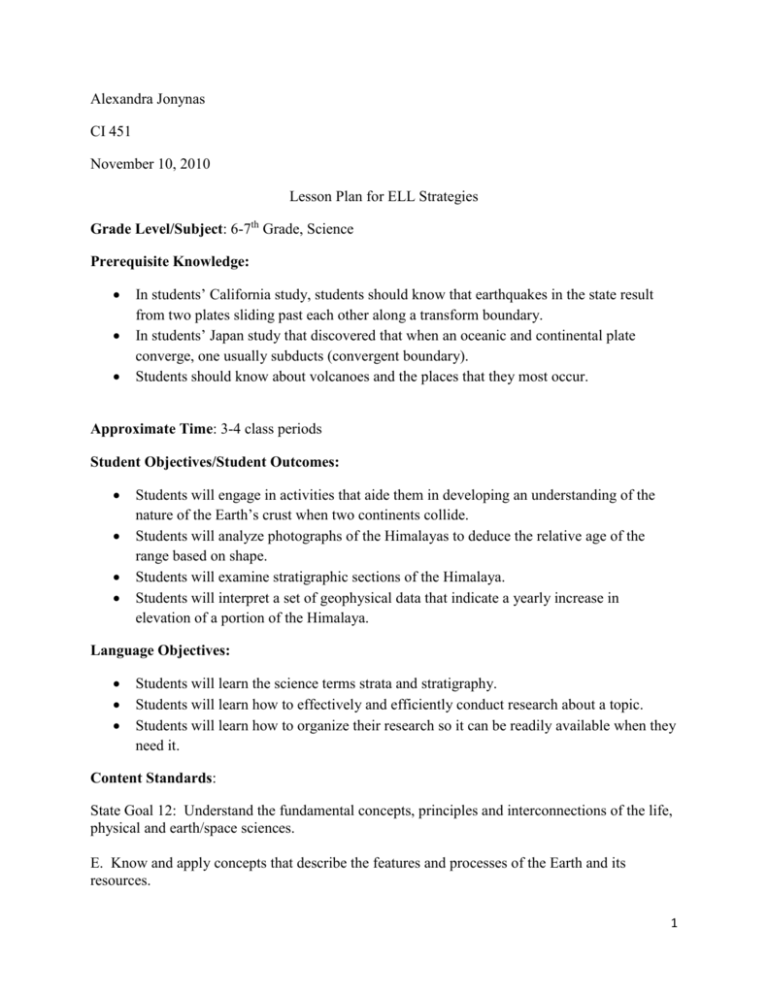
Alexandra Jonynas CI 451 November 10, 2010 Lesson Plan for ELL Strategies Grade Level/Subject: 6-7th Grade, Science Prerequisite Knowledge: In students’ California study, students should know that earthquakes in the state result from two plates sliding past each other along a transform boundary. In students’ Japan study that discovered that when an oceanic and continental plate converge, one usually subducts (convergent boundary). Students should know about volcanoes and the places that they most occur. Approximate Time: 3-4 class periods Student Objectives/Student Outcomes: Students will engage in activities that aide them in developing an understanding of the nature of the Earth’s crust when two continents collide. Students will analyze photographs of the Himalayas to deduce the relative age of the range based on shape. Students will examine stratigraphic sections of the Himalaya. Students will interpret a set of geophysical data that indicate a yearly increase in elevation of a portion of the Himalaya. Language Objectives: Students will learn the science terms strata and stratigraphy. Students will learn how to effectively and efficiently conduct research about a topic. Students will learn how to organize their research so it can be readily available when they need it. Content Standards: State Goal 12: Understand the fundamental concepts, principles and interconnections of the life, physical and earth/space sciences. E. Know and apply concepts that describe the features and processes of the Earth and its resources. 1 12.E.3a Analyze and explain large-scale dynamic forces, events and processes that affect the Earth’s land, water and atmospheric systems (e.g., jetstream, hurricanes, plate tectonics). 12.E.3b Describe interactions between solid earth, oceans, atmosphere and organisms that have resulted in ongoing changes of Earth (e.g., erosion, El Nino). WIDA Standards: (Students in the class are in level 3: Developing) Indentify characteristics and conditions related to natural disasters based on text and pictures. Compare differences based on information from charts or graphs. Describe processes and procedures as well as retell events. Materials/Resources/Technology: World map or globe One set of the six Stratigraphy Sheets Transparent tape 1 metric ruler Students’ field notebook Implementation: Time 5-8 minutes Opening of lesson: (Objectives, hook, behavior expectations) On the large class globe or map (or if available, students can have their own map or globe in their groups) the teacher should ask students to point out the area northeast of India and ask students if they know the name of the country (Nepal) and any other information about the country. The teacher should ask students if they know the name of the famous mountain range in this region (The Himalayas). If students do not know the name of the mountain range, the teacher should pull up a detailed labeled map of the region and then have students point out on the map the mountain range. The teacher should then tell students that this is the mountain range that students’ will be learning and exploring about in their groups. So before jumping into the lesson, the teacher should allow students to research about the Himalayas and collect facts to share before starting the lesson. Students should focus on discovering how the Himalayas are a good example of “erosion”. The teacher can have each student group share one or two interesting facts from their research to the class. Students should record their research in their science journals. 2 35 minutes Procedures: Include critical thinking questions and accommodations for individual needs As students are looking and researching pictures of the Himalayas students should focus their research on the following questions: “Based on their shape, what would you say about how much erosion these mountains have experienced?” and “Depending on how much erosion the mountains experienced, what does that indicate about their age?” This research will also lead students to explore the relative age of the Himalayas and students should be encouraged to create a timeline to represent their information (Students can use meter tape to represent the timeline or they can represent the time a creative way of their choice.) To structure the research each group will receive graphic organizers that will aide students in discovering answers to the two questions above as well as organize their research. Students will then have an opportunity to present their timelines and their information they collected in their field note books to the class. This is a great opportunity for students to work as real scientists because as each group presents, other groups have an opportunity to add their data in their journals as well. After students have presented, students will learn about the stratigraphy of the Himalayas. Before the lesson the teacher should remind students of the clay models of sedimentary rock layers they created and ask students if they remember what each layer is called. Then the teacher should explain to students that they are going to study strata (the layers of rock) to gain a better understanding of processes that formed important geologic structures in the past. By examining the strata, students will learn more about the Himalayas. Next, each team will receive 6 pages of strata from the Himalayas and students are to piece the strata together based upon the labels on the sheets. Each piece is labeled with how high above sea level they are. Once students have completed their stratigraphy sheets, the teacher should walk around and ask each group questions about the sheets to make sure the groups understand how to read and interpret them. Students are then to fill out their Stratigraphy Data Sheet (which will be inputted in their field notebooks). The Data sheet poses questions to students about the rock layers of the Himalayas. After, students will have an opportunity to explore the Gloster page that provides interactive online resources for them in order to see the strata in a more detailed version. The teacher should post the questions below on the border so students will know what questions to expect in the whole class discussion. The teacher will create a grand discussion with the class with the following questions: “When you observed the different strata, did you notice anything interesting of puzzling?” “How could the discovery of marine fossils at such 3 high elevations relate to the way in which the Himalayan Range were formed?” “What can you infer about the movement of plates based on your investigation of the Himalayas?” Students should be reminded that they must keep record of their notes and responses in their field notebooks. Summary/Closing: The class will discuss the follow up questions to their investigation on the Himalayas. Assessment: Students’ science journals will be assessed following each “field trip”. There will be a general rubric that the teacher will use for each journal. Rationale: This lesson plan utilizes ELL strategies in many ways. When teachers are instructing English language learners it is important for them to make the information they are teaching comprehensible as much as possible. In the beginning of the lesson when the class is locating the Himalayan Mountains on their maps, the teacher confirms the location by pointing to it on a large scale easy to see map in the front of the classroom. This will help students who are unaware or confused on what they are supposed to find. When students are researching about the Himalayan Mountains they are given a graphic organizer to help them organize their ideas as well as structure what information they should be looking for in their research. After the research portion of the lesson the students engage in an activity that demonstrates to them how the strata of the Himalayan Mountains can be used to determine the relative age of the mountain. This activity is very hands on and allows students to manipulate the materials and model what the mountains are constructed of. By physically modeling the strata, ELL students are able to visually understand what the mountains look like and their partners (or teachers) can help by pointing out the details in the strata. Students will also be able to visually see the real life strata with the use of the internet. All of these strategies help support English Language Learners by assisting them in non-verbal ways. 4
